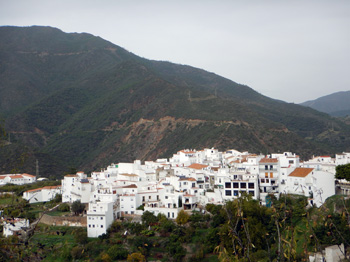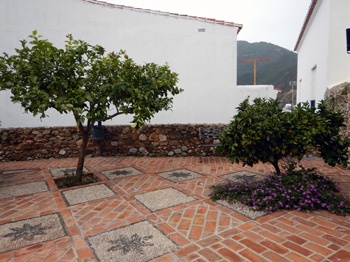
by Darlene Foster
The road appears to be going nowhere as it winds its way around the precipices, over gorges and through rocky landscapes. Tired of the busy beach towns of the Costa del Sol, we turned off the highway at a sign indicating Istan, a while ago. We round another hairpin curve, still no village in site. Have we taken a wrong turn? Should we turn back? Our inquisitive minds compel us to go further up into the desolate cliffs. Another twist and turn and there it is, a white village nested in the arms of a mountain.
 Created for mules and packhorses, the narrow streets are steep and best experienced on foot. We park the car and explore this village of Moorish roots dating back to 1448. A map painted on a whitewashed wall provides a guide around the historic section. We wander the almost perpendicular avenues, passing quaint tiled courtyards decorated with flowers and greenery in terracotta pots. The pristine white houses accented with charming old wooden doors are postcard worthy. We soon reach Juana de Escalante Passage, the remainder of the centre of the old Muslim town, tucked in a side street.
Created for mules and packhorses, the narrow streets are steep and best experienced on foot. We park the car and explore this village of Moorish roots dating back to 1448. A map painted on a whitewashed wall provides a guide around the historic section. We wander the almost perpendicular avenues, passing quaint tiled courtyards decorated with flowers and greenery in terracotta pots. The pristine white houses accented with charming old wooden doors are postcard worthy. We soon reach Juana de Escalante Passage, the remainder of the centre of the old Muslim town, tucked in a side street.
 This was the site of a Moorish rebellion in 1568. The niece of the cleric, Juana de Escalante, stopped the rebels by throwing stones at them from the tower until aid came from Marbella. All that remains is the site the tower once stood on, the round archway and the courtyard through which horses passed through on the way to the stables. Standing there I sense the walls could tell many stories over the centuries. I look down and observe the detailed tile work on the ground. It is a work of art.
This was the site of a Moorish rebellion in 1568. The niece of the cleric, Juana de Escalante, stopped the rebels by throwing stones at them from the tower until aid came from Marbella. All that remains is the site the tower once stood on, the round archway and the courtyard through which horses passed through on the way to the stables. Standing there I sense the walls could tell many stories over the centuries. I look down and observe the detailed tile work on the ground. It is a work of art.
Istan remained in existence due to its distance from the coast. After the Christian conquest in the 15th Century, Arab settlements near the Costa del Sol were destroyed due to their close proximity to Africa. The mountain villages however, were not considered a threat.
 Throughout the village is a series of water fountains providing fresh water for the inhabitants over the centuries. The fountains are as attractive as functional; decorated with blue and white tiles, some painted with scenes of the area. The mountain water is prized for its purity.
Throughout the village is a series of water fountains providing fresh water for the inhabitants over the centuries. The fountains are as attractive as functional; decorated with blue and white tiles, some painted with scenes of the area. The mountain water is prized for its purity.
There are a few interesting tapas bars and restaurants in the town. We stop for lunch at the Entresierras Bar and are encouraged by the friendly waiter to sit outside overlooking the gorge and part of the village. The cheerful villagers all speak Spanish and are eager to please. I enjoy a hearty plate of assorted local cheeses and my husband has a fresh fruit salad. A perfect lunch. I am so happy we persevered and found this little out of the way place so well preserved and full of character and history.
Browse Costa Del Sol Tours Now Available
If You Go:
Istan is tucked away beneath the Sierra Blanca at the head of the valley of the rio Verde, close to the Serrania de Ronda hunting reserve. To reach it, leave the N-340 coastal highway 5 kilometres south of Marbella just beyond the Hotel Puente Romano. The road is good but long and windy – about 15 kilometers.
About the author:
Darlene Foster is a dedicated writer and traveller. She is the author of a series of books featuring Amanda, a spunky young girl who loves to travel to interesting places such as the United Arab Emirates, Spain, England and Alberta, where she always has an adventure. Darlene divides her time between the west coast of Canada and the Costa Blanca of Spain. www.darlenefoster.ca
All photos are by Darlene Foster



Leave a Reply
You must be logged in to post a comment.